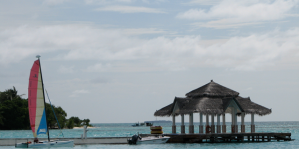The Maldives, a group of about 1,200 islands, separated into a series of coral atolls, is just north of the Equator in the Indian Ocean. Only 200 of the islands are inhabited.
Many of these tropical atolls and islands are simply gorgeous, with swaying palms, white sandy beaches and deep-blue lagoons; none of the islands rise higher than 7.8 ft. above sea level.
These low lying specs of coral are subject to erosion, and stand at the mercy of any sea level rise. Some were severely damaged during the December 2004 Tsunami.
The culture of the Maldives as we know it today developed and flourished sometime around the 3rd century BC, as a 1,400 year-long Buddhist period cemented a foundational importance in the island’s history.
Due to its strategic location, the Maldives secured the interest of Middle Easterners, and by the 10th century AD trade routes were established and Islam was introduced to the region.
Despite being ruled by an independent Islamic sultanate for centuries, the Maldives were taken over by the Dutch in the mid-17th century, and were almost promptly driven out by British forces some years later.
As a British protectorate, the Maldives were given military protection, as well as a non-interference in local administration.
At the emergence of a proposed constitutional monarchy, conflict erupted, and the people of the Maldives pushed for independence.
The Maldives successfully gained their freedom from the United Kingdom in 1965, and three years later, declared itself an independent republic.
Although the Maldives are known the world over for the stunning beaches and azure waters that typify the tropical idyll, its life beneath the water’s surface is becoming ever more respected by divers in the know. The Maldive Islands have some excellent coral reefs, but it’s the abundance of fish life throughout the country that sets it apart from other dive destinations.
Most diving in the Maldives is drift dives from liveaboards where you allow the current to move you along. Due to the myriad channels and passages between the atolls, the currents sweep and play throughout the island

